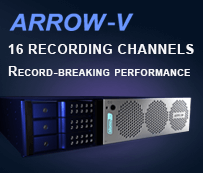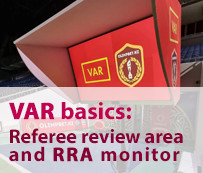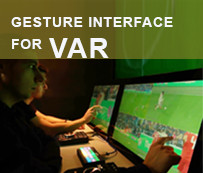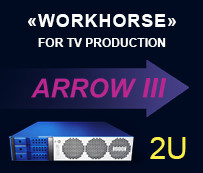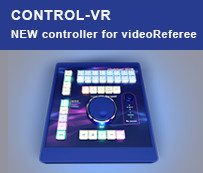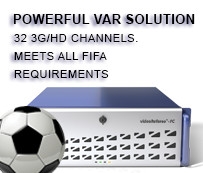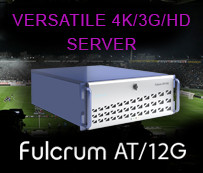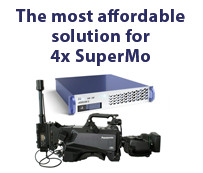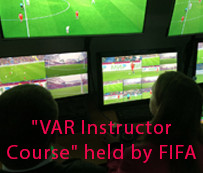Any video-refereeing system involves recording from cameras. At first VAR was using signals from TV broadcaster cameras. These cameras provide high-quality images and, as a rule, work synchronously: they produce the same number of frames in the same time period and their shutters are triggered simultaneously. However, they are controlled by cameramen and it may turn out that although the system recorded many cameras, the video needed for review is simply missing. We also shouldn’t forget that the broadcaster might not be present at all competitions.
Based on these factors, the most appropriate solution is to use for VAR systems the dedicated cameras. This allows placing the cameras in the designated locations that provide the most complete overview of the field, targeting them at the desired area or object, and setting the correct viewing angle. The optimal positioning of cameras also allows minimizing the number of the recording channels. There is no need to worry that a certain moment will not be recorded.
Since adding cameras leads to additional costs, one of the requirements is cameras at an affordable price. In this regard, the cameras that output SDI video and IP cameras are considered.
IP cameras - not the best choice for a VAR system
Low cost and a wide product range are the main advantages of IP cameras. They are connected with a widely available standard twisted-pair cable. However, nowadays IP cameras are quite rarely used in video-refereeing for a very simple reason: these cameras are not synchronous and the transmission of video over IP makes the task of synchronizing video streams difficult to implement. This makes them unsuitable for analyzing the moments, which are related to timing or require determination of the object's position at a certain point in time.
- Details
- Written by: Igor Vitiorets, CTO
What is the "right" interface and what should it be? A good example was the green telephone receiver button on old push-button phones. On the first click it opened the list of recent calls, and with a second click it dialed the last called number. This fast, intuitive and simple operation could be done even with your eyes closed. Modern smartphones certainly have much more functionality, but this has significantly complicated the interface. To speed dial the last number you need to unlock the phone, exit any opened app, go to the "calls" menu, open the tab with recent calls and select a number.
That push-button mobile phone had a simple, fast and intuitive high-performance interface, also due to the fact that it could work "blindly".
Like phones, the functionality of video replay systems over decades has significantly expanded and become more complex. Considering that these systems work in real time, a particularly careful approach to the development of the interface and system controls is required.
Why is the performance and user-friendliness of the interface so important for replay systems, and what benefits does a proper interface bring?
The "right" interface allows the replay operator to easily navigate through the ongoing events and quickly prepare replays, performing more actions in a limited period of time. That in turn leaves more time for orientation in sports situations for creating more pertinent and beautiful replays. The operator better selects the right moments and makes better transitions from one camera to another.
- Details
- Written by: Igor Vitiorets, CTO
Any video-refereeing system involves recording by a specialized video server material from cameras located in accordance with the technical regulations of a competition. Needless to say, specialized cameras are better suited for this task. These cameras were designed to take into account the conditions of use and peculiarity of the particular sport. Our slomo.tv specialized cameras for video-refereeing systems mini-II-vR-Cam have all the necessary features and functions - compact size, built-in controlled zoom lens, remote control settings, Power over Ethernet (PoE) technology, as well as CloudyGenLock® technology to synchronize cameras with each other and with the scoreboard controller.
Theoretically, similar results can be achieved using professional or prosumer cameras. These cameras have far more functions than needed, and can not be used in video-refereeing at their full potential. The price of such cameras is also higher.
In order to offer the customers complete video-refereeing solutions at a reasonable cost, we have created our own specialized referee cameras. If the project budget is limited, we recommend and can supply Marshall cameras that are small, lightweight and have SDI output.
Sometimes there are specific tasks, which, on the one hand, are characterized by a limited budget for the cameras, but on the other hand require the presence of wide zoom range lenses and time limits for system installation. Such specific tasks often arise in sports such as basketball, volleyball, water polo or wrestling.
- Details
- Written by: Igor Vitiorets, CTO
Compact size, light weight, SDI output and affordable price – these are the undeniable advantages of Marshall CV503 cameras. For projects with a limited budgetIt they are a great tool. Slomo.tv, as a dealer of Marshall Electronics, recommends using these cameras in low-budget VAR (video assistant referee) projects. However, it is worth exploring and considering the peculiarities of using these cameras, imposed by their design solution reflected as a consequence of the low price.
One feature of the Marshall CV503 cameras that should be definitely taken into account is the absence of a built-in lens. The advantage of this solution is the lower price for the camera and its smaller size. The negative side is the need for completing the camera with a separately purchased lens, which needs to be carefully selected to provide a “correct” image (viewing angle, depth of field), matching the "geometry" of a particular arena. A good solution is to use zoom lenses, which allow the user to adjust the camera image. Unfortunately, the product range of zoom lenses for this camera is very limited, and there are no wide-range zoom lenses or wide-angle lenses. Also, most of the zoom lenses for the CV503 do not have a remote control. This means that for any setup – both when installing at a new place, and for image adjustment during operation – a specialist who will manually set up each camera is needed, including the cameras in the hard-to-reach places. Often clubs or sports arenas simply do not have such a specialist. This disadvantage becomes clearly evident not only during installation, but also during the sports event, since it is not possible to quickly access the cameras.
Due to the compact size of the CV503, the M12 bayonet-type lens mount is used. This solution significantly limits the choice of lenses for the camera. In turn, the compact size of the lens made possible by the use of this mount type imposes limitations on the image quality.
To provide a low price for CV503 cameras Marshall excluded the Genlock function - external synchronization - which ensures that all cameras in a video-refereeing system operate at the same frame and line frequency and are synchronized by phase.
- Details
- Written by: Igor Vitiorets, CTO
Sports competitions and other important events are usually broadcasted live, because people like to watch and follow the events without knowing the final result. They are curious about whether their favorite team will make it to the next stage of the competition, or whether the space launch will be successful. When the outcome is already known, the interest in the event is quickly lost.
The creation of a spectacular broadcast and retention of viewers' attention is the responsibility of a group of creative professionals who need to align their actions with the changing course of an event or sports competition, such as a football or a hockey match.
On air work it means a quick change of focus, strict time limits, and necessity to anticipate the development of a situation. That explains the high requirements for qualification and skills of production directors, cameramen, video engineers and graphics specialists.
For a long time, such people on live broadcasts "were worth their weight in gold". Training of these personnel was long and difficult. Getting practical experience based on theoretical knowledge was possible only on live broadcasts with a small number of viewers and low level of responsibility.
To simplify the training process for TV specialists working at live sporting events, Slomo.tv in 2010 developed the "Academy" system. The "Academy" is a specialized server with a library of clips for training sports production directors, replay operators, and CG specialists. The principle of the "Academy" training is quite simple – to recreate as closely as possible the workflow in a studio or OB Van by using the real footage of events. In fact, the "Academy" is an emulator of a sports competition and cameras that are used for its broadcast.
- Details
- Written by: Igor Vitiorets, CTO



